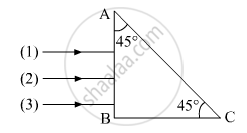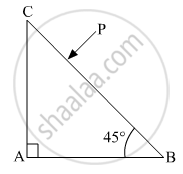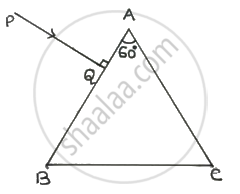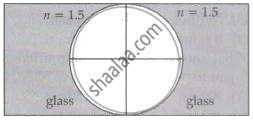Advertisements
Advertisements
प्रश्न
A prism is made of glass of unknown refractive index. A parallel beam of light is incident on the face of the prism. The angle of minimum deviation is measured to be 40°. What is the refractive index of the material of the prism? The refracting angle of the prism is 60°. If the prism is placed in water (refractive index 1.33), predict the new angle of minimum deviation of a parallel beam of light.
उत्तर
Angle of minimum deviation, δm = 40°
Angle of the prism, A = 60°
Refractive index of water, µ = 1.33
Refractive index of the material of the prism = µ'
The angle of deviation is related to refractive index (µ') as:
µ' = `(sin (("A" + δ_"m"))/2)/(sin "A"/2)`
= `(sin ((60° + 40°))/2)/(sin (60°)/2)`
= `(sin 50°)/(sin 30°)`
= 1.532
Hence, the refractive index of the material of the prism is 1.532.
Since the prism is placed in water, let `δ_"m"^"'"` be the new angle of minimum deviation for the same prism.
The refractive index of glass with respect to water is given by the relation:
`μ_"g"^"w" = (μ"'")/μ = (sin (("A" + δ_"m"^"'"))/2)/(sin "A"/2)`
`sin (("A" + δ_"m"^"'"))/2 = (μ"'")/μ sin "A"/2`
`sin (("A" + δ_"m"^"'"))/2 = 1.532/1.33 xx sin (60°)/2 = 0.5759`
` (("A" + δ_"m"^"'"))/2 = sin^-1 0.5759` = 35.16°
60° + `δ_"m"^"'"` = 70.32°
∴ `δ_"m"^"'"` = 70.32° − 60° = 10.32°
Hence, the new minimum angle of deviation is 10.32°.
APPEARS IN
संबंधित प्रश्न
At what angle should a ray of light be incident on the face of a prism of refracting angle 60° so that it just suffers total internal reflection at the other face? The refractive index of the material of the prism is 1.524.
A ray of light passing from air through an equilateral glass prism undergoes minimum deviation when the angle of incidence is 3/4 th of the angle of prism. Calculate the speed of light in the prism.
Three rays (1, 2, 3) of different colours fall normally on one of the sides of an isosceles right angled prism as shown. The refractive index of prism for these rays is 1.39, 1.47 and 1.52 respectively. Find which of these rays get internally reflected and which get only refracted from AC. Trace the paths of rays. Justify your answer with the help of necessary calculations.

A ray of light, incident on an equilateral prism `(μ_g = sqrt3)`moves parallel to the base line of the prism inside it. Find the angle of incidence for this ray.
Trace the path of the ray (P) of light passing through the glass prism as shown in the figure. The prism is made of glass with critical angle ic = 41°.

Suggest a method to produce a rainbow in your house.
A flint glass prism and a crown glass prism are to be combined in such a way that the deviation of the mean ray is zero. The refractive index of flint and crown glasses for the mean ray are 1.620 and 1.518 respectively. If the refracting angle of the flint prism is 6.0°, what would be the refracting angle of the crown prism?
Answer the following question.
Calculate the angle of emergence (e) of the ray of light incident normally on the face AC of a glass prism ABC of refractive index `sqrt(3)`. How will the angle of emergence change qualitatively, if the ray of light emerges from the prism into a liquid of refractive index 1.3 instead of air?

A ray PQ is incident normally on the face AB of a triangular prism of refracting angle 60° as shown in figure. The prism is made of a transparent material of refractive index `2/sqrt(3)`. Trace the path of the ray as it passes through the prism. Calculate the angle of emergence and the angle of deviation.

Two concave refracting surfaces of equal radii of curvature face each other in the air as shown in the figure. The point object O is placed midway between the centre and one of the poles. Then the separation between the images of O formed by each refracting surface is ______.

